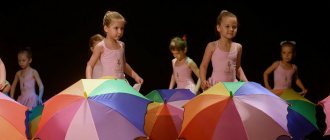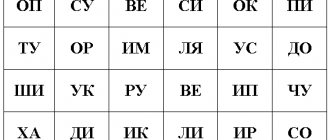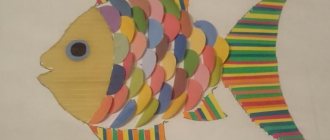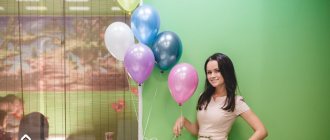Additional general development program "ABVGDeyka School"
Author: Amelina Irina Nikolaevna
Additional general development program
"ABVGDeyka School"
EXPLANATORY NOTE
The additional general developmental program “ABVGDeyka School” is designed for one-year education for children aged 6-7 years.
Speech development involves children mastering basic language units (sounds, words, phrases, sentences) and speech mechanisms (speech perception, creating speech utterances, reproduction). Speech development proceeds in four main directions: development of the sound side of speech, enrichment of vocabulary, work on phrases and sentences, development of coherent speech. These classes focus on the development of two types of speech activity: listening and speaking.
Primary goal:
comprehensive development of the child: formation of learning motivation, development of thinking, imagination, creative abilities, increase in memory capacity, development of attention, speech and the ability to argue one’s statements, identification of individual characteristics of future first-graders and formation of readiness for schooling.
Objectives
of the program:
- develop phonemic hearing;
— develop the articulatory apparatus, diction;
- expand children's vocabulary;
— improve dialogic and monologue forms of speech;
- develop the ability to compose speech statements based on personal impressions, on the basis of what has been heard and read, on the basis of illustrations;
- teach the use of words, phrases and sentences of different types in speech;
- develop the ability to answer and ask questions;
- develop children’s interest in independent verbal creativity, creating stories, fairy tales, poems;
— development of fine motor skills of the hands using rhythmic and finger exercises (outlining, shading, games with pencils, etc.).
General characteristics of the program
Speech development is an integrated course that includes the main areas of development of preschoolers:
· a game;
· familiarization with fiction;
· speech development;
· development of fine motor skills;
· learning to read.
Structurally, speech development classes are divided into several stages. Depending on the content of classes and forms of organization of the educational process, a certain amount of time is allocated to various stages. In some classes, work with cubes, tables and illustrations can be carried out in parallel with work on exercises to develop fine motor skills of the hands using rhythmic and finger exercises. When differentiating tasks, an individual or group form of working with children on the formation and development of reading skills can be used.
As you know, one of the most powerful means of child development is play. While playing, the child is organically integrated into the complex process of mastering various educational skills. At the same time, he masters something that requires a lot of work at school. Literally from the very first steps, learning turns into a desirable, joyful activity for children.
Program content
Development of the sound side of speech
Improve the ability to distinguish by ear and pronunciation all the sounds of the native language. Developing a clear and loud enough correct pronunciation of words, syllables, sounds. Improve phonemic awareness: give an idea of sound, learn to identify individual sounds, name words with a certain sound, determine the place of a sound in a word.
Development of coherent speech
To develop a child’s coherent monologue speech: constructing a coherent statement, retelling a literary work, composing stories, composing fairy tales, riddles. Fostering a culture of verbal communication: detailed answers, the ability to argue your opinion, the ability to listen to your interlocutor and ask him questions.
Enrichment vocabulary
I
Exercise children in selecting words with similar (synonyms) and opposite (antonyms) meanings. Expand your vocabulary of words denoting the names of objects, actions, and signs. To introduce different ways of forming words, to practice the formation of words with the same root, in the comparative and superlative degree of adjectives. Learn to select association words, rhyme words.
The main stages of training for preschoolers
Stage
I -
orientation classes
At this stage, preschoolers get acquainted with the teacher and the children of the group, the features of learning. There is a so-called “getting used to” in a new role, in new conditions. The main forms of organizing children's activities are role-playing games, games with didactic material, conversations about the rules of behavior at school and at home, etc.
Stage
II -
memorizing warehouses
At the stage of memorizing warehouses, the child must comprehend and understand warehouse mergers (MA, MO, MU, WE, ME, mya, me, mu, mi, etc.). In this work, both individual and group forms of organizing classes are used.
III
- entering a word, sentence, text
The duration of this stage varies for children, since each child is individual in his development (according to the characteristics of psychological functions, temperament, etc.). Children master speech production at different times: some earlier, some later. Work on developing the skill of reading words is individually differentiated. At this stage, work begins on “printing” (writing in block letters) warehouses and words in a large-checked notebook.
Children who have previously mastered the word as a unit of speech are more successful in making sentences. Children get acquainted with sayings, proverbs, and proverbs. Work continues on the development of fine motor skills: typing, tracing letters with fingers.
More successful children are more successful in reading texts: excerpts from works, short fairy tales, poems. The introduction of book font takes place gradually, individually, depending on the acquisition of reading skills by each child. The organization of classes is differentiated: work in a group, in pairs, individual work, choral reading.
Thematic planning
Course program: “ABVGDeyka School” is designed for 1 year of study in the amount of 35 hours (1 hour per week).
| No. | Chapter | Number of hours | |
| Practice | Theory | ||
| 1 | Orientation classes | 2 | |
| 2 | Storage storage | 10 | |
| 3 | Exit in word, sentence, text | 14 | |
| 4 | Rhythmoplasty | 6 | |
| 5 | Culture and technique of speech | 3 | |
| TOTAL | 35 hours | ||
Description of methodological support of the educational process
Educational and methodological manuals for teachers:
Ovechkina A.N. ABVGDeyka School. Pre-school training program for 6-year-old children - M.: School Press
Sokhina F.A. Development of speech in preschool children - M.: Ed. 2nd edition
Shvaiko G.S. Games and play exercises for speech development - M.: Education
Davydov V.V. Types of generalization in teaching. — M.: Pedagogical Society of Russia
Belova T.V., Solntseva V.A. Is your child ready for first grade? — M.: Yuventa
Planned results of mastering the speech development program “ABVGDeyka School”:
As a result of educational work, preschoolers acquire a number of skills and abilities necessary for successful learning and adaptation at school.
Children master the following constructive knowledge
(understanding) and
skills
:
1. Developed skill of conscious reading (individually in relation to each child: the child’s ability to read a word or read a book depends on the cognitive and psychological potential of each)
2. The ability to tell from a picture, retell stories, fairy tales
3.Ability to express your thoughts and formulate questions correctly
4. Show interest in reading and respect for the book
5. Articulation, diction, correct pronunciation of sounds
Calendar and thematic planning
| Lesson number | Lesson topic | Types of exercises |
| 1 | Let's get acquainted. Tour of the school | Game: Let's get acquainted. Learning tongue twisters |
| 2 | Polite words. Rules of school life. A. Barto “To school” | Writing a story |
| 3 | My family. How did the bread come to the table? Russian folk tale "Light Bread" | Singing “songs” about family members ( m, p, b, d, s) |
| 4 | Animals wild and domestic. Who lives where? Fairy tale "Winter quarters of animals" | Singing “songs” about animals ( c, d, h, j, l) |
| 5 | Migratory and wintering birds. A. Fet “The Swallows Are Missing” | Singing “songs” about animals ( n, r, t, x) |
| 6 | How do children help adults? Tools. A. Barto “The Helper” | Singing songs. Consolidation. |
| 7 | Different professions. Courageous professions. J. Rodari “What do crafts smell like?” | Getting to know the warehouses. Singing “songs” in warehouses (with letters AND I) . |
| 8 | Passenger and special transport. Traffic Laws | Singing “songs” in warehouses (with letters Oh, Yo) . |
| 9 | Times of Day. Daily regime. Days of the week. Fairy tale "Khavroshechka" | Singing “songs” in warehouses (with letters U, Yu) . |
| 10 | Toys. My favorite toy. V. Kataev “Flower - seven flowers” | Singing “songs” in warehouses (with letters Y, I) . |
| 11 | Rules of personal hygiene. K. Chukovsky “Moidodyr” | Singing “songs” in warehouses (with letters E, E) . |
| 12 | K. Chukovsky “Doctor Aibolit” | Singing “songs” in warehouses. Consolidation. |
| 13 | Politeness lessons. Good words. V. Oseeva “The Magic Word” | Making words from warehouses. |
| 14 | School supplies. A. Barto “How good it is to be able to read!” | Making words from warehouses. |
| 15 | Hello, guest Winter! V. Odoevsky “Moroz Ivanovich” fairy tale. | Making words from warehouses. |
| 16 | Folk winter games and entertainment. | Making words from warehouses. Reading words from folded cards. |
| 17 | Russian folk tale "Zayushkina's Hut". | Making words from warehouses. Reading words from folded cards. |
| 18 | What is frost? N. Obraztsov “Frosty day” | Making words from warehouses. Reading words from folded cards. |
| 19 | What is a mood? A. Barto “Carrot juice” | Making words from warehouses. Reading words from folded cards. Printing warehouses and words. |
| 20 | What is friendship? N. Nosov “Karasik” | Reading words from folded cards. Printing warehouses and words. |
| 21 | What is friendship? L. Tolstoy “Two Comrades” | Reading words from folded cards. Printing warehouses and words. |
| 22 | Visiting a fairy tale. My favorite fairy tales. Russian folk tale "Kolobok" | Reading words from folded cards. Printing warehouses and words. |
| 23 | Fairy tales. Russian folk tale "Two Frosts" | Reading words from folded cards. Printing warehouses and words. |
| 24 | Tales about animals. Russian folk tale "Teremok" | Reading words from folded cards. Printing warehouses and words. |
| 25 | Game "Travel through Fairy Tales" | Strengthening reading and writing skills. |
| 26 | Talking on the phone. Game "Telegraph". N. Nosov “Telephone” | Strengthening reading and writing skills. |
| 27 | Exercises to develop word creativity. Game "Finish the word" | Strengthening reading and writing skills. |
| 28 | Entertaining tales about the Merry Tongue | Strengthening reading and writing skills. |
| 29 | Let's learn to speak correctly. Game “Living Words” (compiling a picture dictionary) | Strengthening reading and writing skills. |
| 30 | Teaching creative storytelling. “The words are mixed up” (working with deformed text) | Strengthening reading and writing skills. |
| 31 | Teaching creative storytelling. Basics of articulatory gymnastics. | Consolidation. |
| 32 | Teaching creative storytelling. | Consolidation. |
| 33 | Communication culture. Speech epithet. | Reading texts. |
| 34 | Communication culture. Rules of communication at school. | Reading texts. |
| 35 | Soon I will become a schoolboy. Rules of conduct at school. A. Barto “I grew up” | Reading texts. |
comments powered by HyperComments
MAGAZINE Preschooler.RF
Literacy program "ABVGDEyka" (5-7 years)(educational field: speech development)
Developed by: teacher - speech therapist of MDOU No. 6 Dorzhieva A.A. village Mountain 2012
Ι. Explanatory note
Federal State Standard of Preschool Education
determines target guidelines - social and psychological characteristics of the child’s personality at the stage of completion of preschool education, among which speech occupies one of the central places as an independently formed function, namely: by the end of preschool education, the child understands oral speech well and can express his thoughts and desires.
Preschool age is the most favorable age for the development and education of a child. This is due to the accelerated development of the psychophysiological functions necessary for this period. The child is distinguished by sharpness and freshness of perception, curiosity and vividness of imagination. An important place is occupied by the development of thinking and the process of development of speech perception. Of course, it is important to develop not only speech, but also the ability to listen and hear, understand the difference between letters and sounds, the ability to retell and compose stories yourself. Many children show an early interest in learning to read and write, and the prerequisites for this are being formed.
Teaching literacy to preschool children is a mandatory element of an integrated approach to teaching children their native language and speech development, when in one lesson various interrelated speech tasks are solved - phonetic, lexical, grammatical - and on their basis - the development of coherent speech.
This program is based on image-based teaching. The basis is made up of fairy tales - but not ordinary, “elementary” ones . With their help, the child should discover graphic images of letters and learn to correlate letters with sounds. It is very useful and important for children to tell fairy tales, because they carry powerful psychotherapeutic potential. Their main purpose is to “nourish the soul . A child, as a rule, does not just listen to a fairy tale. He lives it.
The program is intended for children 5-7 years old, who, due to their psychological characteristics, can fantasize about a fairy tale and play it “based on” , but are not always ready to laugh at the fairy tale. A fairy tale for them -
this is serious. For them, this is a full-fledged, full-fledged reality.
Thus, the program combines the artistic principle of teaching with the phonetic principles of literacy teaching. And the logic of the unfolding of fairy-tale events determines its structure no less than the logic of science.
Each lesson and course as a whole is built on:
- the principle of progression from simple to complex;
- the principle of relying on the interests of preschoolers and parents;
- the principle of psychological comfort;
- the principle of development of a creative personality.
The methodology for conducting circle classes involves an integrated approach combined with visual and playful techniques. During the lesson, the basic principle of education is implemented - the principle of observing the triune task: education, development, training.
Teaching methods:
- Visual;
- Verbal;
- Practical
The goal of the program is to form a full-fledged phonetic system of the language through the use of “alphabetic” fairy tales.
Program objectives.
Educational:
- Teach children to master the sound side of speech - tempo, intonation;
- Carry out sound analysis of a word using various means (scheme of the composition of the word, intonation highlighting of sounds in the word);
- Introduce children to the syllabic structure of words;
- Develop the ability to correctly construct a sentence, use prepositions, extend a sentence, use the construction of a complex sentence;
- Develop the ability to retell, compose short stories from pictures, using simple sentences;
- Expand children's vocabulary.
Educational:
- Develop auditory perception;
- Develop graphic skills;
- Develop hand coordination, fine motor skills of fingers, accuracy of movement, differentiated perception, attention, memory.
Educational:
- Develop the ability to work in pairs;
- Develop independence when performing tasks;
- To cultivate moral qualities, namely tolerance, goodwill towards others;
- Introduce children to fiction.
Expected results:
- Be able to distinguish between the concepts of “sound” and “letter” ;
- Carry out sound analysis of a word using various means (scheme of the composition of the word, intonation highlighting of sounds in the word);
- Determine the place of sound in a word;
- Characterize the sound (vowel - consonant, hard - soft, voiced - unvoiced), proving your answer in competent scientific language;
- Be able to divide words into syllables and perform sound analysis of the word;
- Be able to identify a stressed syllable and a stressed vowel sound in a word;
- Know all the letters of the Russian alphabet, be able to convey them graphically on the board;
- Be able to work in a squared notebook, observing all the requirements of printed writing;
- Be able to correctly use grammatical forms to accurately express thoughts.
This program is modified and is based on the use of “ABC Tales” by M.S. Aromshtam, as well as for the Program for the education and training of children with phonetic-phonemic underdevelopment T.B. Filicheva, G.V. Chirkina; teaching literacy to children with speech disorders E.V. Kuznetsova, I.A. Tikhonov.
The program lasts 2 years. Number of classes – 1 time per week. Duration – 25-30 minutes. The program is implemented within the framework of the ABVGDeyka , where children in a fascinating fairy-tale form get acquainted with letters and sounds, their features, connections and differences.
ΙΙ. Program content
The first stage of the program is designed for teaching children 5-6 years of age. The main task of this stage is to introduce children to the world of sounds and words, promoting the development of phonemic hearing and correct pronunciation of the sounds of their native language. The first stage is designed for 1 year.
The second stage of training solves the problems of developing sound-letter analysis, phonemic perception and preparing the child’s hand for writing. The stage is designed to work with children 6-7 years old.
The implementation of this task takes place on the material of the Russian alphabet.
The structure of the program described above meets the age and psychological capabilities of children and prepares them for further education at school.
ΙV. Mechanism for determining program effectiveness
- testing children in order to identify interests in learning to read and write their native language, determining the orientation of abilities for various types of speech art;
- diagnosing children to identify the level of development of general and specialized skills;
- organization of practical activities taking into account the program content of each year of study and the individual characteristics of children;
- assessment of acquired knowledge (in the form of a survey, game, competition quiz).
Levels of program mastery
Low – the child finds it difficult to answer questions about program content. Uses the help of an adult. Vocabulary is poor. Makes grammatical errors in sound pronunciation. Speech is inexpressive. Makes mistakes when analyzing words soundly and dividing them into syllables. Difficulty in determining stress. Confused about concepts: syllable, sound, letter. Doesn't know the exact names of the letters. Doesn't have reading skills. He gets tired quickly, so working in a notebook is not enough.
Average - in the story the child makes omissions and logical errors, but corrects them himself with the help of adults or peers. Shows interest in verbal communication, but is not active enough in it. There is no difficulty in constructing sentences; grammatical errors are rare. Speech is pure and correct; the child may have difficulty pronouncing certain sounds. Confused about concepts. Possesses the skill of reading words.
Tall – the child has verbal skills, is active and independent. Speech is clear, grammatically correct, expressive. Masters all the means of sound analysis of words, determines the characteristics of sounds in a word (vowel - consonant, hard - soft, stressed - unstressed, place of sound in a word). He is proactive in communication - asks questions, shares impressions, and involves children in communication. Notices children's speech errors and corrects them. Has a rich vocabulary. Unmistakably uses generalizing concepts. Possesses fluent reading skills.
| Next > |





